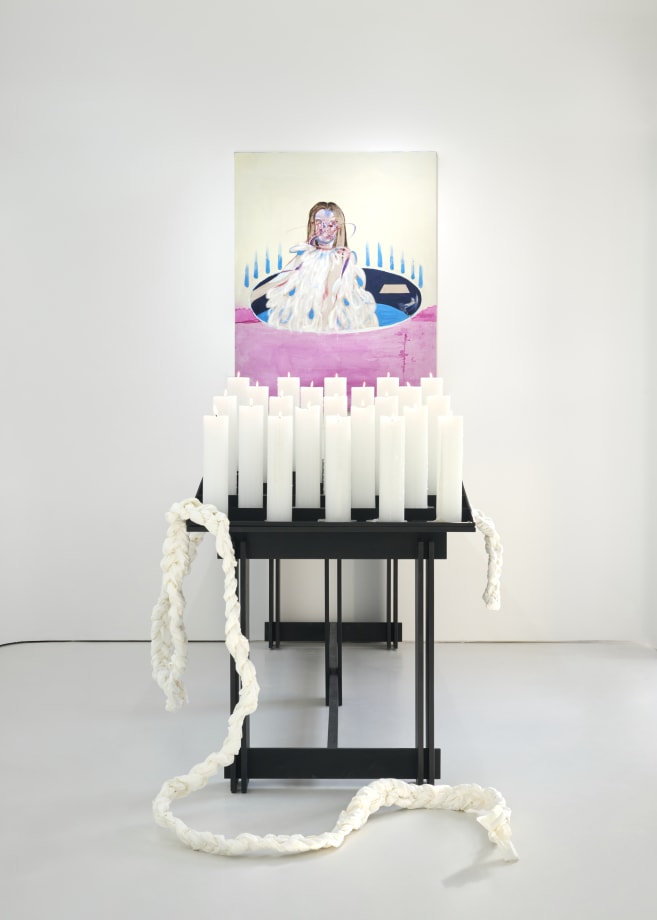THE GIVEN: YEONSU JU
THE THIRD는 2025년 11월 21일부터 12월 27일까지 주연수의 개인전 ‘The Given’을 개최한다. 주연수는 유한한 존재의 영원성을 탐구하며 그에 대한 염원을 작업으로 풀어낸다. 그의 회화는 삶과 죽음, 현존과 부재, 기억과 망각의 경계 위에서 진동하며, 인간의 삶의 ‘끝’이라 불리는 지점에서 ‘영원’의 순간을 발견한다.
주연수는 상실한 이들을 추모하는 ‘기제사(忌祭祀)’에서 영감을 받아, 그 형식을 회화에 차용한다. 그의 작업은 일반적으로 세 가지의 요소로 전개되어 왔다. 인물(figure), 움직임(gesture), 상(table)은 부재하는 이의 혼을 불러오고, 위로하고, 일시적으로 현존하게 만드는 제사 의례를 연상케 했다. 이번 전시에서 작가는 서사성과 장식성을 최대한 배제하고 오직 본질, 즉 인물(figure)의 현존성에 좀 더 무게를 싣는다. 재현을 통해 서사(narrative)를 전달하기보다는 이미지 그 자체로서의 압도(overwhelming image)를 경험하게 하기 위함이다.
축소된 내러티브는 전시 공간을 감각하는 방식으로 대체된다. 전시장에 들어서면 긴 테이블과 그 위에 놓인 촛대를 발견할 수 있다. 빛과 어둠이 교차하는 그 중심에서 작품들은 마치 제단을 둘러싼 초상화처럼 벽면을 따라 자리한다. 불빛에 반사된 잔상이 서로 겹쳐진 듯한 거침없고 자유로운 붓질은 현실을 교란하며 부재한 존재를 상기시키고 그들을 향한 기억을 호출한다. 그 순간 주연수의 인물들은 삶과 죽음의 경계를 넘어, 사라졌으나 여전히 머물고 있으며, 보이지 않지만 생생히 감응하는 존재가 된다.
주연수는 회화의 표면과 존재론적 깊이를 확장하기 위한 새로운 시도로 한지를 선택했다. 이번 전시에 사용된 한지는 박서보 재단으로부터 받은 것으로, 그 표면에는 알 수 없는 원형의 자국이 남아있었다. 작가는 이 표식을 단순한 물질적 흔적이 아니라 시간이 응축된 수행의 기록이자 우연히 개입된 회화적 사건으로 해석한다. 새로 제작된 한지에서는 찾을 수 없는 이 ‘수행자의 동그라미’는 주연수의 작업에 우연적으로 삽입되면서 이미지의 시간성을 심화하는 통로가 된다.
작가는 질 들뢰즈가 프란시스 베이컨의 회화를 설명하며 언급한 ‘돌발 흔적’ 개념에 주목하며, 화면에 남은 수행자의 비의도적인 자취가 자신의 작업과 만나 발생시키는 새로운 감각을 기대한다. 동시에 그는 앙리 베르그송이 언급한 동심원의 구조에서 자신의 회화적 관점을 발견한다. 반복된 수행의 동그라미는 서로 다른 시간의 층위를 담은 기억의 원이며, 주연수의 화면 위에서 과거의 시간을 현재로 소환하는 역할을 한다. 이처럼 주연수는 이미 주어진 것(The Given)에서 발견된 수행의 흔적, 시간의 축적, 기록된 역사로부터 숭고와 제의의 의미를 끌어낸다.
이와 더불어 작가는 한지가 지닌 고유한 시간성과 물성을 적극적으로 받아들인다. 한지는 닥나무 껍질을 삶고 섬유를 분리한 뒤, 물에 풀어 틀 위에 얇게 펼쳐 수일의 건조 시간을 거쳐 만들어진다. 이 느리고 섬세한 과정 속에서 자연스럽게 생긴 섬유의 결과 질감,표면의 흔적들은 시간의 층위를 머금은 기억체로 존재한다. 작가는 이 시간성을 통해 실존의 경계를 탐색한다. 표면에 남은 흔적은 한때 존재했으나 지금은 사라진 것에 대한 증거이자, 부재 속에 여전히 머무는 현존의 징표이기 때문이다. 더 나아가 한지의 물성을 통해 회화가 ‘그리는 행위’를 넘어 ‘드러나는 과정’으로 확장될 수 있음을 탐구한다. 물과 안료가 스며들면 색과 형태는 의도를 벗어나 자연스럽게 번지고 흔들리며, 이미지는 스스로 모습을 드려낸다. 주연수에게 이번 작업은 표현이 아닌 현현의 회화를 실험하는 장이다.
‘The Given’은 사라진 존재를 소환하고 새로운 서사를 구성하기보다, 이미 주어져 있었던 것과 영원의 시간 속에 머물고 있는 존재들을 체감하고 그들과 새롭게 관계 맺는 것에 주목한다. 이로써 주연수의 작업은 상실의 재현이 아닌, 존재 자체가 스스로 드러나기를 기다리는 회화적 의례가 된다.
Yeonsu examines the human desire for permanence within the finite span of life. Her paintings move along the threshold between life and death, presence and absence, memory and oblivion, identifying moments in which the eternal becomes perceptible at the limits of lived experience.
Drawing on the structure of gijesa, a traditional rite of remembrance for the deceased, Yeonsu translates its ceremonial logic into the language of painting. Her practice develops through three recurring motifs: the figure, the gesture, and the table. Taken together, these elements evoke acts of invocation, consolation, and temporary presence, positioning the pictorial act within a framework that reflects ritual attention.
In this exhibition, Yeonsu removes narrative and ornamentation to concentrate on the essential presence of the figure. Rather than mediating meaning through representation, she directs viewers toward a direct and immediate encounter with the image. Visitors enter a dimly lit space anchored by a long table and a candelabrum. The paintings align along the walls like portraits gathered around an altar. As light shifts across their surfaces, her free and expansive brushwork unsettles perception and calls forth the memory of those whose presence continues beyond visibility.
To deepen the material and temporal register of her work, Yeonsu incorporates hanji, traditional Korean paper, as a primary support. The hanji for this exhibition was provided by the PARK SEOBO FOUNDATION and bears faint circular impressions created through sustained manual practice. Yeonsu interprets these marks as accumulated traces of disciplined repetition rather than incidental residues. By integrating them into her compositions, she expands the temporal field of the image and intensifies its material presence.
Her engagement with these accidental traces, informed by Deleuze’s reading of Francis Bacon, resonates with Bergson’s conception of concentric time. The repeated circular gestures function as rings of memory, drawing multiple temporal layers into the present. From what is already given, including the marks of practice, the accumulation of time, and embedded histories, Yeonsu draws a renewed sense of the ceremonial and the sacred.
At the same time, she embraces the inherent materiality of hanji, produced through the gradual preparation and drying of mulberry fibers. The paper’s grain, texture, and irregularities form a corporeal register of time. Yeonsu treats these surfaces as evidence of what once existed and as signs of endurance within absence. As pigment and water penetrate the fibers, form and color move beyond intention, allowing the image to reveal itself through its own material agency.
‘The Given’ does not reconstruct loss or devise a new narrative. Instead, it turns toward what persists, acknowledging those who inhabit the continuum of the eternal and exploring new ways of relating to them. Through this approach, Yeonsu’s painting moves beyond depiction and becomes a ritual practice of revelation, in which existence discloses itself through the material act of creation.

